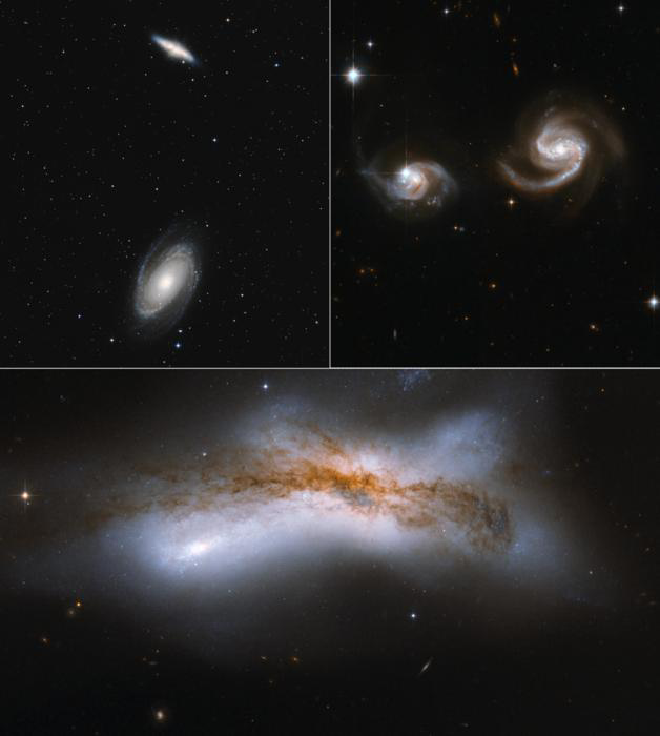
The two galaxies are currently heading towards each other at a speed of about 100 kilometres per second.

A collision would be devastating for both galaxies which would be destroyed, leaving behind a spheroidal pile of stars known as an elliptical galaxy.
A lot of simulations #
The team ran 100,000 simulations of both galaxies based on the latest observational data.
This included the effect of the Milky Way’s most massive satellite, the Large Magellanic Cloud (LMC), and importantly, for the first time, including uncertainties in the observables.
¿Just one closer encounter? #
In just over half of the simulated scenarios, the Milky Way and Andromeda experience at least one close encounter, before losing enough orbital energy to eventually collide and merge - but in eight to ten billion years’ time, not five.
On that timescale the Sun will have already burnt itself out.
In most other cases, the two galaxies pass at such a large distance that they continue to evolve largely unperturbed for a very long time.
The study has been published in the journal Nature Astronomy.
No mistakes #
Lead author Dr Till Sawala of the University of Helsinki emphasised that the new conclusions do not imply a mistake in the earlier calculations, rather the team were able to include more variables in their simulations thanks to modern data from the space telescopes.
A YouTube video about Milky Way and Andomeda colliding. This vídeo isn’t from the researchers of the article we are reading about.
Dr Sawala said: “When we tried to start from the same assumptions as previous researchers, we recovered the same results."
“We’ve simply been able to explore a much larger space of possibilities, taking advantage of new data."
“While some earlier works had focused on the interaction between the Milky Way, Andromeda, and the Triangulum galaxy, we also include the effect of the LMC.
“Although its mass is only around 15% of the Milky Way’s, its gravitational pull directed perpendicular to the orbit with Andromeda perturbs the Milky Way’s motion enough to significantly reduce the chance of a merger with the Andromeda galaxy."
“And while earlier studies only considered the most likely value for each variable, we ran many thousands of simulations, which allowed us to account for all the observational uncertainties.”
No Milkomeda? #
Study co-author, Professor Alis Deason of Durham University’s Institute for Computational Cosmology, added: “These results are significant for the fate of our Galaxy."
“It used to appear destined to merge with Andromeda forming a colossal ‘Milkomeda’."
“Now, there is a chance that we could avoid this fate entirely.”
Looking ahead #
This new uncertainty about the future of the Milky Way and Andromeda may not last, as the team are already looking ahead to researching further scenarios when even more data become available.
The Gaia space telescope will soon deliver more precise measurements of some of the most crucial variables within the galaxies, including the transverse motion of Andromeda which is difficult to measure directly.
The Universe is dynamic #
Leading cosmologist, Professor Carlos Frenk of Durham University, said: “The Universe is a dynamic place, constantly evolving."
“We see external galaxies often colliding and merging with other galaxies, sometimes producing the equivalent of cosmic fireworks when gas, driven to the centre of the merger remnant, feeds a central black hole emitting an enormous amount of radiation, before irrevocably falling into the hole."
“Until now we thought this was the fate that awaited our Milky Way galaxy."
“We now know that there is a very good chance that we may avoid that scary destiny."
“When I see the results of our calculations, I am astonished that we are able to simulate with such precision the evolution of gigantic collections of stars over billions of years and figure out their ultimate fate."
“This is a testimony to the power of physics allied to the power of large supercomputers.”, he concluded.
- The paper No Certainty of a Milky Way- Andromeda Collision has published in Nature Astronomy. Authors: Til Sawala, Jehanne Delhomelle, Alis J. Deason, Carlos S. Frenk, Jenni Häkkinen, Peter H. Johansson, Atte Keiraanranta, Alexander Rawlings & Ruby Wright.
- Funding: Open Access funding provided by University of Helsinki (including Helsinki University Central Hospital).

